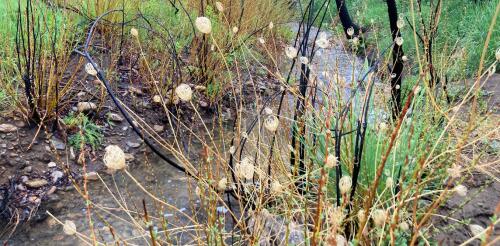Boulder
A tiny, vibrant world thrives along the rocky bottom of most streams. As sunlight filters through the water, mayfly nymphs, no larger than your fingernail, cling to algae-coated cobbles. Their brushlike mouthparts scrape the greenish coating, leaving faint trails as they feed. Six spindly legs anchor them against the current, while feathery gills wave gently, drawing oxygen from the flowing water. This scene is common in well-maintained creeks and streams that flow through populated areas. But when wildfires sweep through, the toxic materials left behind can devastate this ecosystem. When you think of urban wildfires, you might picture charred trees and houses. But beneath the surface of nearby streams, fires can also cause a silent upheaval – one that affects populations of creatures that are important indicators of the water’s health. Images of some of the benthic invertebrates that help keep streams healthy, and whose disa...
Colorado has highly pathogenic avian influenza – also known as HPAI or bird flu – on a dairy farm, the ninth state with confirmed cases. The U.S. Department of Agriculture’s National Veterinary Services Laboratories confirmed the virus on April 25, 2024, in a herd in northeast Colorado. This farm is one of 35 dairy farms across the U.S. with verified cases of bird flu in cattle as of May 7, 2024, according to the USDA. Bird flu is not new to Colorado. The state experienced an outbreak in poultry that began in 2022. Since then, the USDA’s Animal and Plant Health Inspection Service has reported that 6.3 million birds in nine commercial flocks and 25 backyard flocks have been affected by the virus. The most recent detection was in February 2024. But this is the first time the disease has made cattle in Colorado sick. I’m a veterinarian and epidemiologist at Colorado State University who focuses on infectious diseases in dairy cows. I spent many years...
Bat populations in Colorado may be headed for a decline that could cause ecological disruptions across the state. Two bats discovered in Boulder County in late February 2024 were confirmed to have white-nose syndrome, a deadly fungal disease. Additional bats in Larimer County also tested positive for white-nose syndrome early this spring. The first North American bats with white fungus on their faces, ears and wings were discovered in 2006 in caves where they hibernated near Albany, New York. The fungus causes bats to lose nutrients and moisture through their skin and to wake early from hibernation in search of food and water. The disease spread west quickly, reaching Washington state in 2015 and California four years later. It was confirmed in Montana and New Mexico by 2021. Evidence of the fungus was first reported in Colorado in the summer of 2022. I’m a bat biologist, and most of my research has focused on the genetics of Myotis bats. Knowing which bat populations a...
Gray wolves were reintroduced to Colorado in December 2023, the latest attempt in a decadeslong effort to build up wolf populations in the Rocky Mountain states. SciLine interviewed Joanna Lambert, professor of wildlife ecology and director of the American Canid Project at the University of Colorado Boulder, who discussed how and why gray wolf populations declined in the U.S. and the value of reintroducing them to ecosystems in the West. Dr. Joanna Lambert discusses the gray wolf restoration campaign. Below are some highlights from the discussion. Answers have been edited for brevity and clarity. How can protecting gray wolf populations affect ecosystems? Joanna Lambert: Apex predators, and predators in general, are disappearing from landscapes around the planet. Without apex predators, their prey species can become overly abundant. But when apex predators are reintroduced, prey populations decrease and vegetation can rebound. So in cert...
This article is part of a collaboration with Boulder Reporting Lab, The Center for Environmental Journalism at the University of Colorado Boulder, KUNC public radio and The Conversation U.S. to explore the impacts of the devastating Marshall Fire one year after the blaze. The series can be found at the Boulder Reporting Lab. On Dec. 30, 2021, one of the most destructive wildfires on record in Colorado swept through neighborhoods just a few miles from our offices at the University of Colorado Boulder. The flames destroyed over 1,000 buildings, yet when we drove through the affected neighborhoods, some houses were still completely intact right next to homes where nothing was left to burn. Although the people who lived in these still-standing homes were spared the loss of everything they owned, when they returned after the fire, they found another disaster. Noxious smells and ash on their windowsills and doorways initially made their homes unlivable – and potentially hazardo...




